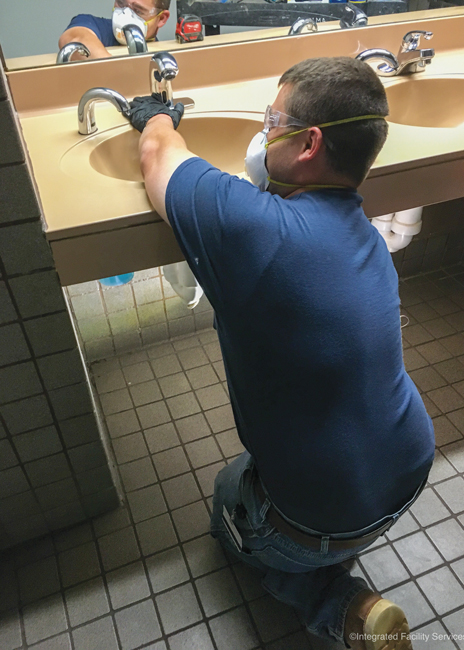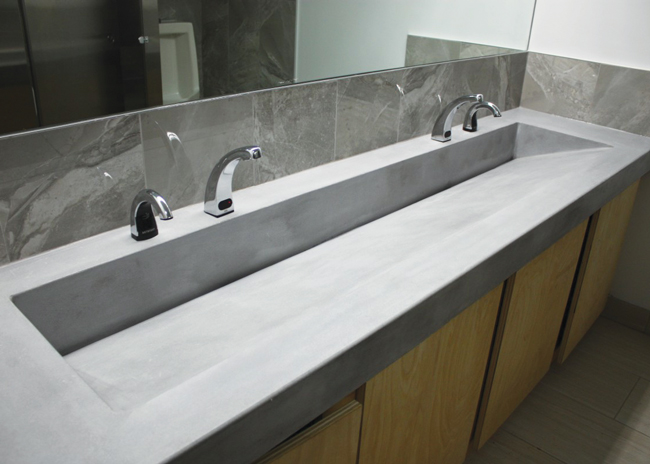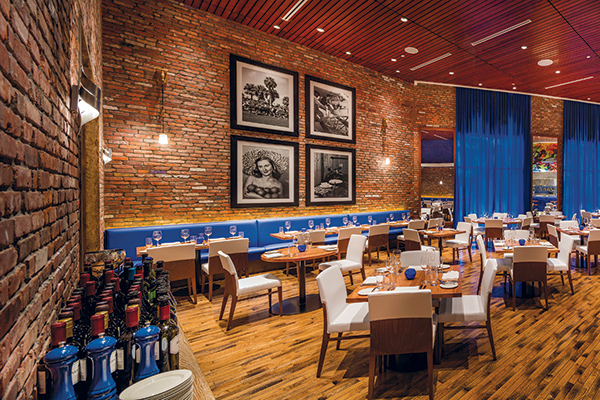The adoption of touchless bathroom fixtures was well underway before COVID-19 upended the restaurant industry. But the coronavirus added fuel to this trend as more building owners installed hands-free restroom fixtures to reduce the spread of disease.
With current technology, it’s possible for a guest to enter a bathroom, use the toilet, wash and dry their hands, and exit without touching any surface that could transmit a pathogen. Building owners have used the COVID-19 shutdowns as an opportunity to retrofit fixtures to create this hands-free environment in their restrooms.
In the restaurant industry, the touchless trend before the pandemic was particularly strong in both the high-end and food hall segments, according to Dana Foley, design director, senior associate, for the architecture firm Gensler. After the widespread business shutdowns in March 2020, the adoption pace picked up in other segments.
“A lot of clients were asking for price quotes for touchless fixtures before COVID,” says Kevin O’Meara, project engineer, Integrated Facility Services, a national mechanical contractor and service provider. After the pandemic took hold, many more have been inclined to actually adopt hands-free fixtures in both new construction and renovation, he says.
Several restroom components are available in touchless styles:
- Faucets
- Soap dispensers
- Hand dryers
- Paper towel dispensers
- Toilet flushers
- Doors
Except for doors, these features have been installed in many public restroom settings for well over a decade. Before the past few years, however, manufacturers tended to position touchless products individually instead of grouping them in lines with matching aesthetics. So, it was more likely for designers to adopt these fixtures as one-offs, and not specify them as a cohesive whole.
Now, manufacturers are offering touch-free components in families with complementary aesthetics, Foley says. When touchless fixtures debuted on the market, they were available in limited styles — primarily coming in shiny nickel and chrome finishes. In recent years, manufacturers expanded the palette significantly and also improved the underlying technology.
“They have more beautiful aesthetics and have become more durable,” Foley says. Faucet finishes, for example, now include brass, bronze, and black — brushed or matte — and are available in numerous shapes and sizes.
Faucets
Despite durability improvements, because touchless faucets have more mechanical parts than conventional models, they tend to require more maintenance, O’Meara points out. Touchless faucets contain a solenoid valve that opens and closes a rubber diaphragm to control water flow. These valves can fail after a few years of use, and it’s not uncommon for them to need replacement.
 This sink system with touchless faucets and soap dispensers is completely hands-free to use. Additionally, the sink assembly does not have seams with grout that could harbor pathogens. Image courtesy of GenslerTouchless controls do have notable advantages in functionality, however. They limit water flow by operating only when the sensor detects hands under the faucet. By doing so, touchless faucets reduce water use significantly, save money, and are less vulnerable to vandalism.
This sink system with touchless faucets and soap dispensers is completely hands-free to use. Additionally, the sink assembly does not have seams with grout that could harbor pathogens. Image courtesy of GenslerTouchless controls do have notable advantages in functionality, however. They limit water flow by operating only when the sensor detects hands under the faucet. By doing so, touchless faucets reduce water use significantly, save money, and are less vulnerable to vandalism.
In most cases, you can find comparable-looking soap dispensers to complement a faucet’s aesthetic. Soap dispensers come in wall-mounted and countertop-mounted models, with the latter having a soap reservoir hidden below the counter. Many wall-mounted dispensers have an institutional appearance, but some are available in finishes suitable for high-end restaurants. Undercounter units are mostly hidden, with only the nozzle visible to the user. Soap dispensers that have larger reservoirs will not have to be refilled as often and are recommended for high-volume establishments.
Both faucets and soap dispensers come in battery-operated or hard-wired models. Batteries, of course, need to be replaced periodically, upping the need for maintenance. Battery models are easier and cheaper to install, though, O’Meara says, particularly on retrofits of existing spaces, because hard-wired units require an electrician to cut into walls to establish an electrical connection. Replacing a battery is a simple task that can be included in a regular maintenance protocol. “When you have grease traps cleaned, you could have the maintenance company also replace the battery packs in the bathrooms,” he says.
Hand dryers
Touchless hand-drying options include paper towel dispensers that offer individual towels or dispense serrated segments of paper on large rolls that users pull manually, electric-powered paper roll dispensers, and electric air dryers. Paper dispensers must be regularly monitored and refilled when necessary. This may be burdensome to employees in high-volume establishments. Electric dryers could be a better option in the busiest restaurants, though they are more costly. Dryers come in two basic forms: those that blow air through the bottom and blade-type models in which the user places hands between two wings that blow air. Some models feature adjustable airspeeds, and an on/off heater option.
Some patrons prefer towels to air dryers, which can be very loud as they force air at a high speed. Many establishments provide both options — paper and air-drying models — satisfying both preferences and providing redundant technology. If a towel dispenser runs out of paper, there will be an air dryer available. If the air dryer fails, paper towels will be available.
All air dryers must be hard-wired. Some air dryers have a modern, high-tech look, though finish and color options are limited. “There are some hand dryers sold within an integrated touchless bathroom system,” Foley says. These models are designed to be in harmony with the look of the other restroom fixtures.
Auto flushers
Most of us have experienced touchless toilet flushers that do not function correctly. Occasionally, they don’t flush when they are supposed to or phantom flush for no apparent reason. These incidences should not happen if the optical sensor control is set properly, which is sometimes a tricky task.
“We cannot set sensors until the entire bathroom is done, including the partitions and floor tiles,” O’Meara explains. Optimal calibration of the optical sensor requires that the area it scans appears exactly as it will be when the unit is activated. Otherwise, the toilet flush valve may not perform correctly. “We’ve seen some toilets, that we haven’t installed, flush when the viewfinder catches someone’s feet,” O’Meara says. In other locations, improperly set sensors flush when they detect toilet paper flapping after a stall door is open or closed.
 The mechanisms that make touchless faucets and soap dispensers function are hidden beneath counters. Image courtesy of Integrated Facility ServicesAs touchless toilets and urinals have increased market share over the past several years, installers have gained more competence in setting optical sensors. “Plumbers are getting more efficient at installing sensor toilets because they are installing more of them,” Foley observes.
The mechanisms that make touchless faucets and soap dispensers function are hidden beneath counters. Image courtesy of Integrated Facility ServicesAs touchless toilets and urinals have increased market share over the past several years, installers have gained more competence in setting optical sensors. “Plumbers are getting more efficient at installing sensor toilets because they are installing more of them,” Foley observes.
Some touchless flush valves are available in hard-wired form, but these, like other hard-wired fixtures, are more expensive to install if electric lines need to be added. Many models use batteries. Automated flush valves can be backed up with a manual flush option, providing a backstop in case the touchless valve’s battery dies or the sensor unit fails. Some of these can be operated by foot, a more sanitary option than using one’s hand.
In general, touchless flush valves are only available in limited finishes with polished chrome being the predominant form. Hidden by stalls, their appearance is less important than faucets, soap dispensers and drying units.
When choosing touchless fixtures, it is advantageous to select your options from a single manufacturer, Foley says. “If you have the ability to maintain the fixtures with parts from one manufacturer and have warranties with the same manufacturer, you will be better off,” she says. This is especially true for multi-location businesses.
Manufacturers have been marketing touchless units more aggressively and educating designers and contractors about their merits and functionality. “Manufacturers are coming to us with mobile models that prove their systems work,” Foley says.
Doors
In the quest for a 100% touch-free restroom, the most difficult component to make hands-free is the door. Few establishments have adopted touchless open/close functionality. One reason: few automated touchless open/close devices are on the market. Fully automated doors use low voltage power to operate electromechanical hardware and a motion sensor to open doors with a wave of the hand. “Most of these products are limited and hard to source,” Foley says.
Other door-opening options can reduce the number of hands that touch a door. Arm and foot pulls offer ways to open doors without grasping hardware by hand. This is the simplest and least expensive way to achieve hands-free door operation. Foot pulls with pads that protect the user’s shoes are mounted near the bottom of the door. For this option to work, the door can’t be too heavy, or many will be unable to open the door using their feet. Elderly or disabled people may have trouble using this option even in the best of circumstances, however.
Electromechanical door holders keep doors open, allowing unencumbered movement through doorways after activation, often by pushing a large button that can be done with a forearm or elbow. These are common in doctor’s office buildings or other locations with frequent handicapped visitors. These are uncommon in restaurant settings, though. Any such unconventional door-opening options should be accompanied by signage to let users know how to use them.
Code requirements
With the pandemic having a profound impact on society, it stands to reason that building codes in the future may require touchless restroom features. “There are not any such requirements now, but cities are moving toward requiring touchless in all public restrooms,” Foley says. “I see it coming.”
“If that requirement comes, it’s more likely to be from a health inspector rather than from building codes,” O’Meara says. “I haven’t come across any hands-free mandates yet.”
Many restaurateurs are not waiting for such mandates. As the pandemic ebbs, customers will be more aware of sanitary practices when they return to dining in crowded spaces. Touchless bathrooms may demonstrate that an establishment takes care to provide a healthy environment for guests.




